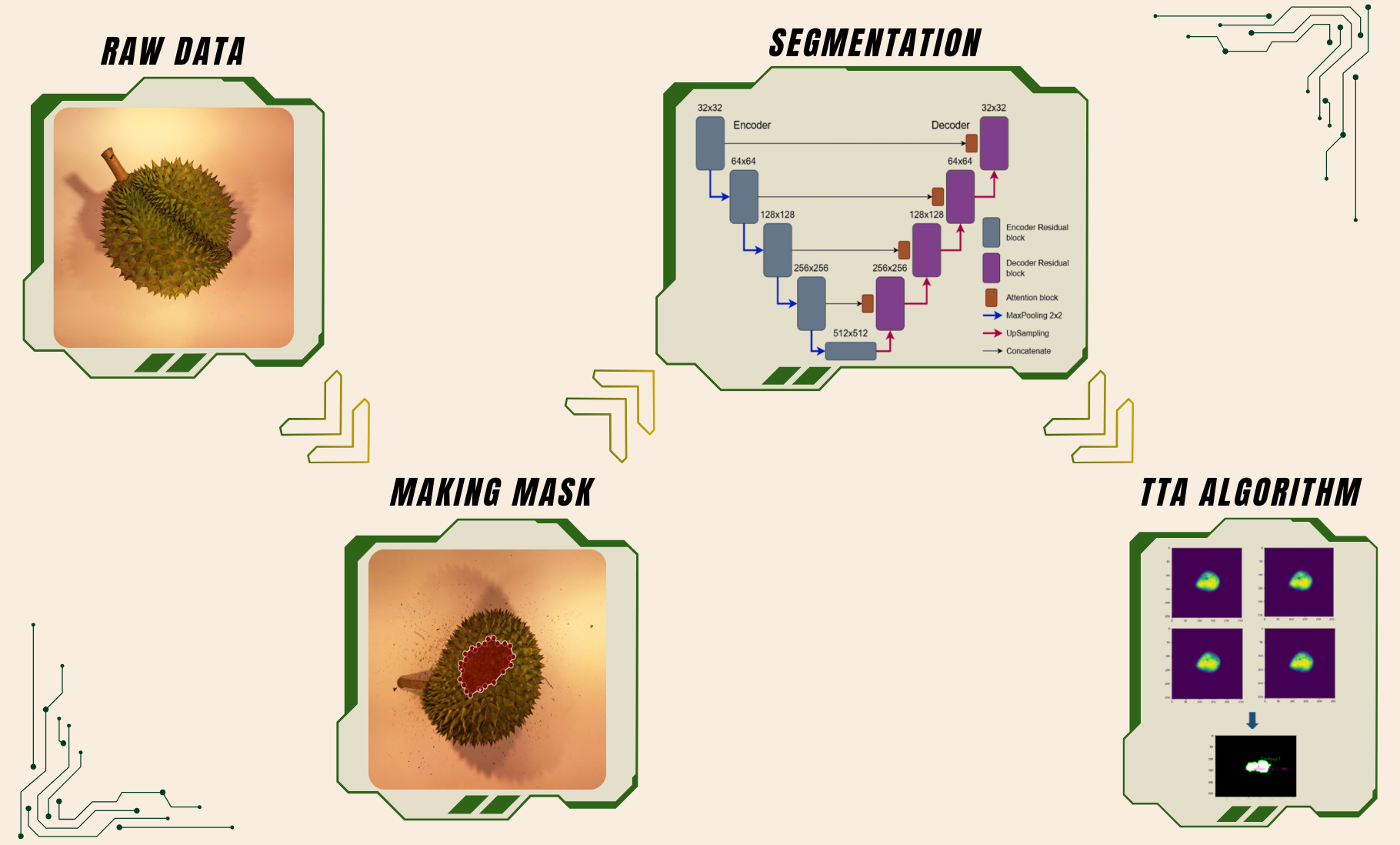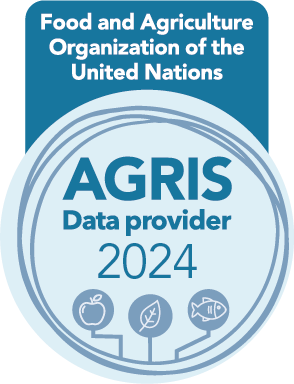Applying artificial intelligence in durian fertile lobe detection: Attention-Residual Unet and Test Time Augmentation algorithm
DOI:
https://doi.org/10.17268/sci.agropecu.2025.038Keywords:
Durian, fertile locule’s center, Unet, Att-Unet, Att-ResUnet, Test time augmentationAbstract
The key factor in durian fruit trading is ripeness. Several studies have been conducted on non-destructive durian maturity classification using near-infrared (NIR) spectroscopy. However, most of these studies manually determined the most accurate measurement position, which was the durian's main fertile lobe center. This research aims to automate the stage of detecting this position of the durian by using UNet segmentation method, which leverages differences in rind texture between the center of the main fertile lobe and other areas (lobe grooves and stems), prior to conducting NIR measurements. The rough and non-uniform surface of the durian rind presents a significant challenge for segmentation. However, the large size of the durian spines in the main fertile lobe serves as an identification characteristic for the segmentation model. This study uses the Ri-6 durian in Vietnam as the samples for the experiment. The model was developed using three architectures: Unet, Attention-Unet and Attention-Residual Unet. According to the analysis results on test set, Unet, Attention-Unet and Attention-Residual Unet algorithms achieved %accuracy of 78.22%, 81.34%, 82.89% and %intersection over union of 79.49%, 80.47%, 80.72%, respectively. After that, the model was further enhanced using the test time augmentation algorithm, improving the %accuracy to 85.24%, 85.68%, 86.85% and %IoU to 81.65%, 82.03% and 83.12%. Among the three architectures, the Attention-Residual-Unet model demonstrated the highest efficiency in detecting the center of the durian’s main fertile lobe for non-destructive durian maturity classification. This method can be applied to the development of an automatic durian’s maturity classification machine, which would save time and improve economic efficiency.
References
Ditcharoen, S., Sirisomboon, P., Saengprachatanarug, K., Phuphaphud, A., Rittiron, R., & Terdwongworakul, A. (2023). Improving the non-destructive maturity classification model for durian fruit using near-infrared spectroscopy. Artificial Intelligence in Agriculture, 7, 35–43. https://doi.org/10.1016/j.aiia.2023.02.002
Enshaei, N., Ahmad, S., & Naderkhani, F. (2020). Automated detection of textured-surface defects using UNet-based semantic segmentation network. IEEE International Conference on Prognostics and Health Management (ICPHM). Detroit, MI, USA, pp. 1-5. https://doi.org/10.1109/ICPHM49022.2020.9187023
Glinpratum, S.-a. (2003). Thai Agricultural Commodity and Food Standard: Durian. National Bureau of Agricultural Commodity and Food Standards . TAS 3-2003.
Hashim, N. M., Bahri, M. H., Ghani, S. M., Sulistiyo, M. D., Kassim, K. A., & Zahri, N. A. (2022). An Introduction to A Smart Durian Musang King and Durian Kampung Classification. IEEE Xplore. https://doi.org/10.1109/CONIT55038.2022.9847909
He, K., Zhang, X., Ren, S., & Sun, J. (2016). Deep Residual Learning for Image Recognition. IEEE https://doi.org/10.48550/arXiv.1512.03385
Ibtehaz, N., & Rahman, M. S. (2019). MultiResUNet : Rethinking the U-Net Architecture for Multimodal Biomedical Image Segmentation. Neural Networks 121, 74–87. https://doi.org/10.1016/j.neunet.2019.08.025
Li, Y., Guo, R., Li, R., Ji, R., Wu, M., & Chen, D. (2025). An improved U-net and attention mechanism-based model for sugar beet and weed segmentation. Front. Plant Sci., 15, 1449514. https://doi.org/10.3389/fpls.2024.1449514
Likhitpichitchai, P., Khermkhan, J., & Kuhaswonvetch, S. (2023). The Competitiveness of Thai Durian Export to China’s Market. GMSARN International Journal, 17, 371-378.
Lim, M. G., & Chuah, J. H. (2018). Durian Types Recognition Using Deep Learning Techniques. IEEE Control and System Graduate Research Colloquium (ICSGRC 2018). https://doi.org/10.1109/ICSGRC.2018.8657535
Mane, S., Bartakke, P., & Bastewad, T. (2023). Efficient Pomegranate Segmentation with UNet: A Comparative Analysis of Backbone Architectures and Knowledge Distillation. ITM Web of Conferences, 54, 01001. https://doi.org/10.1051/itmconf/20235401001
Men, G., He, G., & Wang, G. (2021). Concatenated Residual Attention UNet for Semantic Segmentation of Urban Green Space. MPDI Forests, 12. https://doi.org/10.3390/f12111441
Montazerolghaem, M., Sun, Y., Sasso, G., & Haworth, A. (2023). U-Net Architecture for Prostate Segmentation: The Impact of Loss Function on System Performance. MDPI Bioengineering, 10, 412. https://doi.org/10.3390/bioengineering10040412
Moshkov, N., Mathe, B., Kertesz-Farkas, A., Hollandi, R., & Horvath, P. (2020). Test-time augmentation for deep learning-based cell segmentation on microscopy images. Scientific Reports, 10, 5068. https://doi.org/10.1038/s41598-020-61808-3
Mustaffa, M. R., Yi, N. X., Abdullah, L. N., & Nasharuddin, N. A. (2018). Durian Recofnition Based on Multiple Features and Linear Discriminant Analysis. Malaysian Journal of Computer Science. Information Retrieval And Knowledge Management Special Issue, 2018. https://doi.org/10.22452/mjcs.sp2018no1.5
Neyestanak, M. S., Jahani, H., Khodarahmi, M., Zahiri, J., & Hosseini, M. (2022). A Quantitative Comparison between Focal Loss and Binary Cross-Entropy Loss in Brain Tumor Auto-Segmentation Using U-Net. SSRN. http://dx.doi.org/10.2139/ssrn.4142314
Ngoc, N., Dang, L., Ly, L., Thao, P., & Hung, N. (2024). Use of the Diagnosis and Recommendation Integrated System (DRIS) for Determining the Nutritional Balance of Durian Cultivated in the Vietnamese Mekong Delta. Horticulturae, 10(6), 561. https://doi.org/10.3390/horticulturae10060561
Oktay, O., Schlemper, J., Folgoc, L. L., Lee, M., & Heinrich, M. (2018). Attention U-Net: Learning Where to Look for the Pancreas. Medical Imaging with Deep Learning. https://doi.org/10.48550/arXiv.1804.03999
Pascua, O., & Cantila., M. (1992). Maturity indices of durian (Durio zibethinus Murray). Philippine Journal of Crop Science, 17(3), 119-124.
Puttipipatkajorn, A., Terdwongworakul, A., Puttipipatkajorn, A., Kulmutiwat, S., & Sangwanangkul, P. (2023). Indirect prediction of dry matter in durian pulp with combined features using miniature NIR spectrophotometer. IEEE Access, 11, 84810-84821. https://doi.org/10.1109/ACCESS.2023.3303020
Qurri, A. A., & Almekkawy, M. (2023). Improved UNet with Attention for Medical Image Segmentation. Sensors, 23, 8589. https://doi.org/10.3390/s23208589
Rehman, A., Butt, M. A., & Zaman, M. (2023). Attention Res-UNet: Attention Residual UNet With Focal Tversky Loss for Skin Lesion Segmentation. International Journal of Decision Support System Technology (IJDSST), 15(1), 1-17. https://doi.org/10.4018/IJDSST.315756
Rehman, H. H., & Rehman, M. (2022). 2D UNET Segmentation of Mitochondria of Electron. International Research Journal of Modernization in Engineering Technology and Science. https://www.doi.org/10.56726/IRJMETS29962
Saifullah, S., & Drezewski, R. (2023). Modified Histogram Equalization for Improved CNN Medical Image Segmentation. Procedia Computer Science, 225, 3021–3030. https://doi.org/10.1016/j.procs.2023.10.295
Siriphanich, J. (2011). Durian (Durio zibethinus Merr.). Postharvest Biology and Technology of Tropical and Subtropical Fruits Cocona to Mango Woodhead Publishing Series in Food Science, Technology and Nutrition, 80-114, 115e-116e. https://doi.org/10.1533/9780857092885.80
Sulaiman, A., VatsalaAnand, SheifaliGupta, A. R., & HaniAlshahrani. (2024). Attention based UNet model for breast cancer segmentation using BUSI dataset. Scientific Reports, 14, 22422. https://doi.org/10.1038/s41598-024-72712-5
Weng, W., XinZhu, Jing, L., & MianxiongDong. (2023). Attention Mechanism Trained with Small Datasets for Biomedical Image Segmentation. Electronics, 12(3), 682. https://doi.org/10.3390/electronics12030682
Zhang, Z., Liu, Q., & Wang, Y. (2018). Road Extraction by Deep Residual U-Net. IEEE Geoscience and Remote Sensing Letters, 15(5), 749-753. https://doi.org/10.1109/LGRS.2018.2802944

Downloads
Published
How to Cite
Issue
Section
License
Copyright (c) 2025 Scientia Agropecuaria

This work is licensed under a Creative Commons Attribution-NonCommercial 4.0 International License.
The authors who publish in this journal accept the following conditions:
a. The authors retain the copyright and assign to the magazine the right of the first publication, with the work registered with the Creative Commons attribution license, which allows third parties to use the published information whenever they mention the authorship of the work and the First publication in this journal.
b. Authors may make other independent and additional contractual arrangements for non-exclusive distribution of the version of the article published in this journal (eg, include it in an institutional repository or publish it in a book) as long as it clearly indicates that the work Was first published in this journal.
c. Authors are encouraged to publish their work on the Internet (for example, on institutional or personal pages) before and during the review and publication process, as it can lead to productive exchanges and a greater and faster dissemination of work Published (see The Effect of Open Access).




